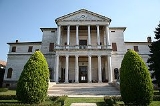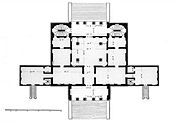
Villa Cornaro
Encyclopedia

Villa
A villa was originally an ancient Roman upper-class country house. Since its origins in the Roman villa, the idea and function of a villa have evolved considerably. After the fall of the Roman Republic, villas became small farming compounds, which were increasingly fortified in Late Antiquity,...
in Piombino Dese
Piombino Dese
Piombino Dese is a comune in the Province of Padua in the Italian region Veneto, located about 35 km northwest of Venice and about 20 km north of Padua...
, about 30 km northwest of Venice, Italy. It was designed by the Italian Renaissance architect Andrea Palladio
Andrea Palladio
Andrea Palladio was an architect active in the Republic of Venice. Palladio, influenced by Roman and Greek architecture, primarily by Vitruvius, is widely considered the most influential individual in the history of Western architecture...
in 1552 and is illustrated and described by him in Book Two of his 1570 masterwork, I Quattro Libri dell'Architettura
I Quattro Libri dell'Architettura
I quattro libri dell'architettura is an Italian treatise on architecture by the architect Andrea Palladio . It was first published in four volumes in 1570 in Venice, illustrated with woodcuts after the author's own drawings. It has been reprinted and translated many times...
[The Four Books on Architecture].
Architectural details
Villa Cornaro was substantially constructed in 1553-1554, with additional work into the 1590s, for Giorgio Cornaro, younger son of a wealthy Venetian family. It represents one of the most remarkable examples of a Renaissance villa. The north façade (illustrated) has an innovative projecting central portico-loggia that is a flexible living space out of the sun and open to cooling breezes. The interior space is a harmonious arrangement of the strictly symmetrical floor plans on which Palladio insisted without exception. Rooms of inter-related proportions composed of squares and rectangles flank a central axial vista which extends through the house. As Rudolph Wittkower noted, by moving subsidiary staircases into the projecting wings and filling matching corner spaces with paired oval principal stairs, space was left for a central salone which is fully as wide as the porticos (plan, left). The central core of the villa forms a rectangle in which there are six repetitions of an elegant standard module. The interior has 18th century frescos by Mattia BortoloniMattia Bortoloni
Mattia Bortoloni was an Italian painter of the Rococo period, mainly active in the area of Bergamo and Venice.Born in Canda, near Rovigo, he died in Bergamo. He trained with Antonio Balestra of Verona. Bortoloni painted the 104-panel fresco cycle at Villa Cornaro, a Palladian villa in Piombino...
and stucco
Stucco
Stucco or render is a material made of an aggregate, a binder, and water. Stucco is applied wet and hardens to a very dense solid. It is used as decorative coating for walls and ceilings and as a sculptural and artistic material in architecture...
s by Camillo Mariani
Camillo Mariani
Camillo Mariani was an Italian sculptor of the early Baroque.He was born in Vicenza. He apprenticed in the studio of the prominent Venetian Mannerist sculptor Alessandro Vittoria, but moved to Rome in 1597. His first works in Rome were stucco statuary for the churches of San Bernardo alle Terme ...
.

Drayton Hall
Drayton Hall, in the South Carolina "Lowcountry" and about 15 miles northwest of Charleston, South Carolina and directly across the Ashley River from North Charleston, South Carolina, is one of the most handsome examples of Palladian architecture in North America.The house was built for John...
(1738-1742) in Charleston, South Carolina, and Thomas Jefferson
Thomas Jefferson
Thomas Jefferson was the principal author of the United States Declaration of Independence and the Statute of Virginia for Religious Freedom , the third President of the United States and founder of the University of Virginia...
's initial version of Monticello
Monticello
Monticello is a National Historic Landmark just outside Charlottesville, Virginia, United States. It was the estate of Thomas Jefferson, the principal author of the United States Declaration of Independence, third President of the United States, and founder of the University of Virginia; it is...
(1768-1770) are early examples of its influence in America.
Conservation
Richard Rush purchased the Villa Cornaro in 1969 from an organization of the Italian Government dedicated to preserving the national monuments of Italy in the Veneto (L'Ente Per Le Ville Venete). He and his wife, Julia, restored the villa and furnished it with antiques over a period of twenty years.The villa is presently owned by Carl and Sally Gable, of Atlanta, Georgia
Atlanta, Georgia
Atlanta is the capital and most populous city in the U.S. state of Georgia. According to the 2010 census, Atlanta's population is 420,003. Atlanta is the cultural and economic center of the Atlanta metropolitan area, which is home to 5,268,860 people and is the ninth largest metropolitan area in...
, who purchased it from Dr. Rush in 1989.
Since 1996 the villa has been conserved as part of a World Heritage Site
World Heritage Site
A UNESCO World Heritage Site is a place that is listed by the UNESCO as of special cultural or physical significance...
, "City of Vicenza and the Palladian Villas of the Veneto
Palladian Villas of the Veneto
The City of Vicenza and the Palladian Villas of the Veneto is a World Heritage Site protecting a cluster of works by the architect Andrea Palladio. UNESCO inscribed the site on the World Heritage List in 1994. At first the site was called "Vicenza, City of Palladio" and only buildings in the...
".
External links
- "Palladio and the Veneto" a catalogue of the villas maintained by www.cisapalladio.org.
- Palladio's Italian Villas (Villa Cornaro-Gable)
- "The Secrets of Palladio's Villas", Carl I. Gable
- Center for Palladian Studies in America, Inc.
See also
- Palladian Villas of the VenetoPalladian Villas of the VenetoThe City of Vicenza and the Palladian Villas of the Veneto is a World Heritage Site protecting a cluster of works by the architect Andrea Palladio. UNESCO inscribed the site on the World Heritage List in 1994. At first the site was called "Vicenza, City of Palladio" and only buildings in the...

